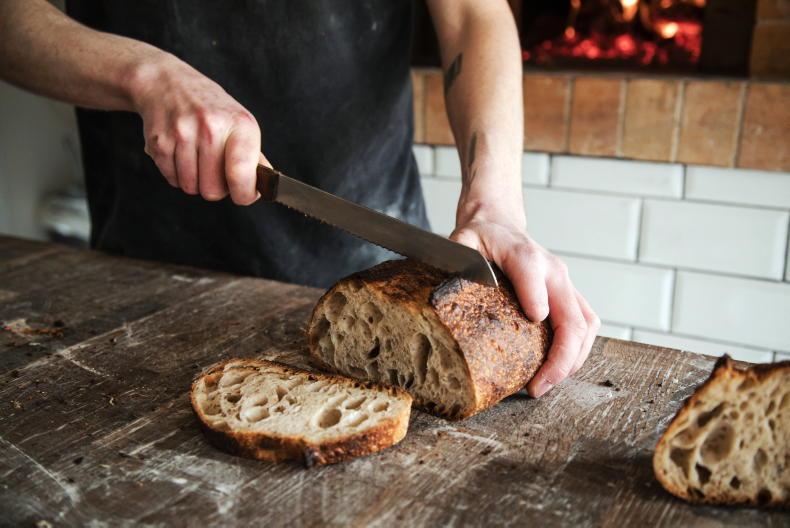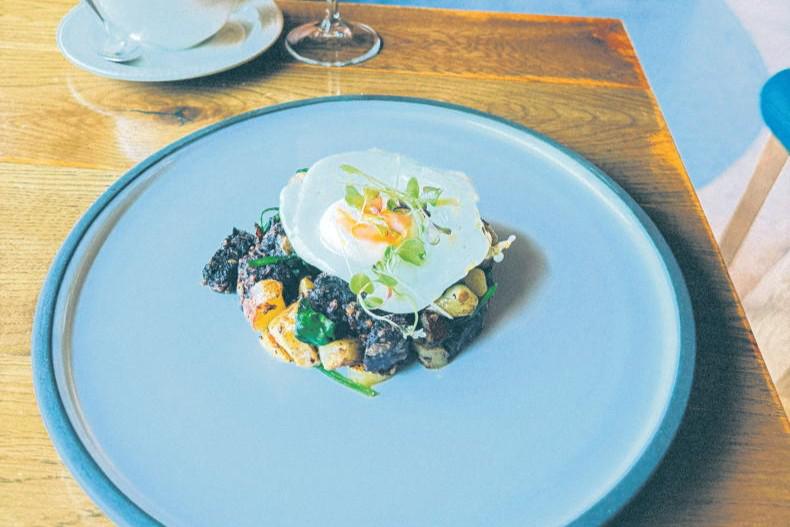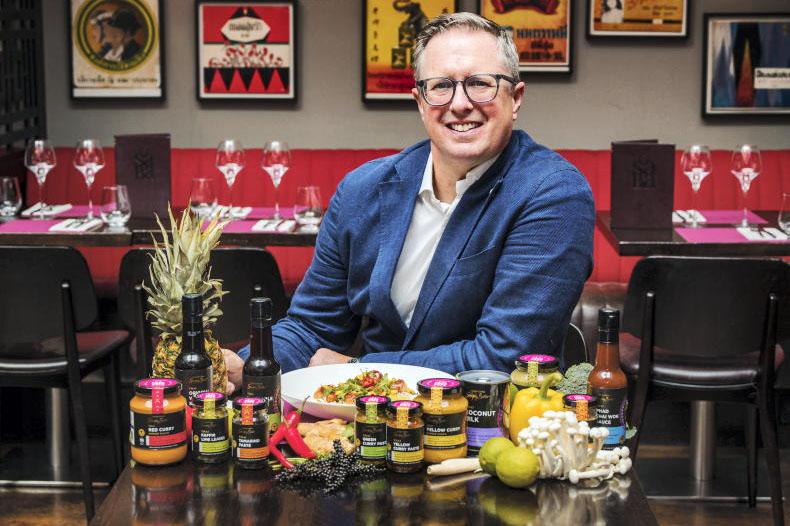Flour is one of the world’s most ancient ingredients; believed to have first been used to make bread in around 6000BC. It can be made from a wide variety of grains, beans, roots or seeds, but cereal (wheat) flour is what we are most familiar with in Ireland.
While at one time we were self-sufficient in milling wheat production, today just a handful of mills exist and Irish tillage farmers have largely stopped growing grain for human consumption. In 2023, 69% of our flour came from the United Kingdom.
In a 2020 report prepared by Professor Michael Wallace (UCD) for Tillage Industry Ireland, it is mentioned that Irish wheat production for flour milling makes up only a tiny share (c.6%) of Ireland’s output.
“In recent years, the loss of commercial flour milling capacity has almost entirely curtailed the Irish milling wheat sector,” it reads. “Since the closure of Odlum’s flour mills in Cork and Dublin, Ireland has imported almost all of its flour requirements, and in 2018 Irish imports of flour exceeded 200,000 tonnes with a value of c.80 million.”
Today, even though we produce some of the highest yield tillage crops in the world, overall tillage area is declining. A common narrative from the past few decades is that our climate is not well suited to growing wheat for flour. Is this truly the case, or is it more, as so many things are, the result of flour being a globalised commodity; more affordable to import than to create?
Irish Grain Network
There are some who are actively working to disprove that narrative. The Irish Grain Network (irishgrainnetwork.com) is a relatively new community of farmers, bakers and chefs, millers and concerned consumers. Their aim is to ensure that more grains are grown in Ireland for human consumption.
One of the network’s founders is Isabel Kelly. Originally from Co Kildare, Isabel has over 20 years of experience within the food and bakery industries. She tells Irish Country Living that she first started questioning the sourcing of wheat for flour while working in product development in the UK.

Isabel Kelly is one of the founders of the Irish Grain Network.
“I was taken aback to learn how much of what I was using was imported – mostly from Kazakhstan and Canada – despite being milled locally,” she says.
In 2018, Isabel became co-director of the UK Grain Lab. During their 2022 Grain Event in Nottingham, she noticed quite a few Irish in attendance.
“We had a newly-interested turnout of Irish parties [14 bakers, millers and farmers],” she explains. “This spurred on the creation of the Irish Grain Network. The network to date has mainly been organised by myself, Grace Maher of the Irish Organic Association [IOA] and with the support of several team members from the GAIA Foundation. We have also been given grants from The Roddick Foundation. [Our last gathering] in October 2023 featured 100 millers, bakers and farmers.”
The goals of the network include reducing dependency on imported grain; formalising a network to have a voice at a national level; and building knowledge and resilience in the Irish grain economy.
“Bringing growers, millers and bakers together has been at the heart of the network from the start,” says Isabel. “From understanding what the market requires, to the constraints on farmers and ensuring the end users have respect and understanding of Irish-grown grain. It is critical that these groups come together to learn from each other.”
Oak Forest Mills
Two members of the Irish Grain Network are Emma Clutterbuck and Pat Foley, co-founders of Oak Forest Mills (oakforestmills.ie) in Piltown, Co Kilkenny. They produce flour from their own organic tillage crops (including spelt, einkorn, emmer and wheat) and also mill grain from a small number of other organic tillage farmers.

Emma Clutterbuck owns and operates Oak Forest Mills with her partner, tillage farmer Pat Foley. \ Donal O' Leary
In production since 2018, Pat and Emma purchased a hand-made stone mill in Austria which they set up in their food-grade premises in Piltown. Their entire business has been self-funded, and they supply Irish artisan bakers.
A tillage farmer all his life, Pat remembers a time when his family grew milling grain, but Emma tells Irish Country Living it was a transition nonetheless when they first began growing for their own mill.
“There is a knowledge element to it,” she says. “Feed wheat is different to milling wheat, where the quality of the grain is key. Pat had to get back into growing milling grain, and he was transitioning to organic at the same time. We had a couple of years of growing before we started milling.”
While the mill’s capacity is 10 tonnes per week, Emma says they are currently producing “nowhere near that”. As they are reliant on their own crops and the crops of just a few other farmers, they also have to adapt to the challenges which all tillage farmers have experienced in current times, dealing mainly with a plethora of bad weather conditions which has reduced crop yields and production. At the time of interview (late April), Pat had decided it was too late to plant milling wheat for this year.
While they plan to increase production in the coming years, at the moment, they are only able to partially supply their bakery customers.
“The bakers would like more good quality Irish flour,” says Emma. “But we need to build up our grain stocks and our milling capacity. I think that as people continue to support their local food producers, we might start to see more mills opening in other locations – we need to expand milling greatly to make this a viable industry.”

Emma and Pat have been milling grain since 2018 in their hand-made stone mill. \ Donal O' Leary
Climate change and conflict have affected crop yields all over the world. During difficult times like these, Emma feels it is even more important to revive older milling traditions and heritage crops which might be more naturally resilient to inclement weather and disease.
“The UK is a huge grain-growing region – they are almost self-sufficient if they needed to be,” she says. “We are almost completely reliant on imported flour and are nowhere near self-sufficiency. My view is that it would be better to start building back our knowledge and infrastructure on milling.”
While Emma would like to see an expansion in Irish grown grain being milled for flour, she also feels it is crucially important to keep the quality of the grain and the resulting flour as high as possible.
“It’s not enough to say it’s Irish, you need to have the best quality so people want to use it. We think, at this stage, we’ve established that we can grow excellent quality grain for flour production in Ireland.”
Plúr goodness in Co Carlow

Seamus Jordan is a sourdough baker who has started growing his own wheat to mill into flour. \ Claire Nash
When Séamus Jordan launched Plúr Bakery in his native Co Carlow, he wanted to do something different. Having worked with Firehouse Bakery in Co Wicklow, and completed work placements in the United States (including Tartine in San Francisco, where his partner Jenna, is originally from), he had the passion and the know-how to create something special.
“I had an acre of land and I was asking myself: what do I want for Plúr? What do I want to give back to my community?” He tells Irish Country Living, “I thought I could make organic sourdough – but how could I find an organic Irish wheat? It wasn’t impossible to find, but was nearly impossible. So I had to figure out how to get a consistent amount. Then Jenna said, ‘You’re just going to have to grow it.’
“I was laughing, but then I thought, ‘I actually think she is right,’ he continues. “So I had that acre. I cultivated it, ploughed it, got it ready and sowed four different varieties of wheat. I had it in the ground and it started to sprout, so it seemed like it was going to work. Then I thought, ‘If this works I have no way of milling it,’ so I started researching flour mills, which were completely new to me.”
With funding from Carlow’s Local Enterprise Office, Séamus purchased an Astreia Mill for making his own flour. With no experience in tillage, however, he faced uncertainty as he navigated his first year of farming.

Seamus produces sourdough bread in his wood-fired oven which he mainly sells wholesale. \ Claire Nash
“There were definitely challenges,” he says. “Reuben Cope [from nearby Shankill Castle] is a farmer and a good friend – I was WhatsApp-ing him every step of the way and sending him pictures of the field.
“The biggest thing I took from that first year is that nature will always find its way to produce,” he adds. “I sowed it all by hand and I rolled it with a little two foot roller [because I had no machinery] and most of it was just on top of the ground; it wasn’t underneath, which it should have been. But it still found a way to produce.”
In his first year, Séamus grew purple wheat, blue wheat, Mariagertoba and Ölands. Of the four types, the best results came from the Mariagertoba. This year, he has acquired a further 13ac which will be planted solely with Mariagertoba.
“For last year’s harvest, I got about 850kg off the whole acre, which was good,” he says. “I’m milling last year’s wheat in stages – 850kg would normally last me about eight weeks. Hopefully, come October I will have a full year’s supply of wheat.”
Séamus uses a wood-fired oven to make his naturally levened sourdough loaves. He sells his bread wholesale within his locality and also offers a click-and-collect option on the Plúr Bakery website (plur.ie).
• We once grew grain for flour and had mills around the country; now we are almost entirely reliant on imported flour
• As climate change and conflict affect crop yields worldwide, some believe Ireland should once again work to be self-sufficient in flour production
• The Irish Grain Network wants Ireland to produce more grains for human consumption
• The network connects chefs, bakers, millers, farmers and concerned consumers to promote a circular system, from field to plate.
Read more
40 years of Irish farmhouse cheese celebrated at 2024 Irish Cheese Awards
PGI Grass-Fed Beef: putting Irish beef on the European map
Flour is one of the world’s most ancient ingredients; believed to have first been used to make bread in around 6000BC. It can be made from a wide variety of grains, beans, roots or seeds, but cereal (wheat) flour is what we are most familiar with in Ireland.
While at one time we were self-sufficient in milling wheat production, today just a handful of mills exist and Irish tillage farmers have largely stopped growing grain for human consumption. In 2023, 69% of our flour came from the United Kingdom.
In a 2020 report prepared by Professor Michael Wallace (UCD) for Tillage Industry Ireland, it is mentioned that Irish wheat production for flour milling makes up only a tiny share (c.6%) of Ireland’s output.
“In recent years, the loss of commercial flour milling capacity has almost entirely curtailed the Irish milling wheat sector,” it reads. “Since the closure of Odlum’s flour mills in Cork and Dublin, Ireland has imported almost all of its flour requirements, and in 2018 Irish imports of flour exceeded 200,000 tonnes with a value of c.80 million.”
Today, even though we produce some of the highest yield tillage crops in the world, overall tillage area is declining. A common narrative from the past few decades is that our climate is not well suited to growing wheat for flour. Is this truly the case, or is it more, as so many things are, the result of flour being a globalised commodity; more affordable to import than to create?
Irish Grain Network
There are some who are actively working to disprove that narrative. The Irish Grain Network (irishgrainnetwork.com) is a relatively new community of farmers, bakers and chefs, millers and concerned consumers. Their aim is to ensure that more grains are grown in Ireland for human consumption.
One of the network’s founders is Isabel Kelly. Originally from Co Kildare, Isabel has over 20 years of experience within the food and bakery industries. She tells Irish Country Living that she first started questioning the sourcing of wheat for flour while working in product development in the UK.

Isabel Kelly is one of the founders of the Irish Grain Network.
“I was taken aback to learn how much of what I was using was imported – mostly from Kazakhstan and Canada – despite being milled locally,” she says.
In 2018, Isabel became co-director of the UK Grain Lab. During their 2022 Grain Event in Nottingham, she noticed quite a few Irish in attendance.
“We had a newly-interested turnout of Irish parties [14 bakers, millers and farmers],” she explains. “This spurred on the creation of the Irish Grain Network. The network to date has mainly been organised by myself, Grace Maher of the Irish Organic Association [IOA] and with the support of several team members from the GAIA Foundation. We have also been given grants from The Roddick Foundation. [Our last gathering] in October 2023 featured 100 millers, bakers and farmers.”
The goals of the network include reducing dependency on imported grain; formalising a network to have a voice at a national level; and building knowledge and resilience in the Irish grain economy.
“Bringing growers, millers and bakers together has been at the heart of the network from the start,” says Isabel. “From understanding what the market requires, to the constraints on farmers and ensuring the end users have respect and understanding of Irish-grown grain. It is critical that these groups come together to learn from each other.”
Oak Forest Mills
Two members of the Irish Grain Network are Emma Clutterbuck and Pat Foley, co-founders of Oak Forest Mills (oakforestmills.ie) in Piltown, Co Kilkenny. They produce flour from their own organic tillage crops (including spelt, einkorn, emmer and wheat) and also mill grain from a small number of other organic tillage farmers.

Emma Clutterbuck owns and operates Oak Forest Mills with her partner, tillage farmer Pat Foley. \ Donal O' Leary
In production since 2018, Pat and Emma purchased a hand-made stone mill in Austria which they set up in their food-grade premises in Piltown. Their entire business has been self-funded, and they supply Irish artisan bakers.
A tillage farmer all his life, Pat remembers a time when his family grew milling grain, but Emma tells Irish Country Living it was a transition nonetheless when they first began growing for their own mill.
“There is a knowledge element to it,” she says. “Feed wheat is different to milling wheat, where the quality of the grain is key. Pat had to get back into growing milling grain, and he was transitioning to organic at the same time. We had a couple of years of growing before we started milling.”
While the mill’s capacity is 10 tonnes per week, Emma says they are currently producing “nowhere near that”. As they are reliant on their own crops and the crops of just a few other farmers, they also have to adapt to the challenges which all tillage farmers have experienced in current times, dealing mainly with a plethora of bad weather conditions which has reduced crop yields and production. At the time of interview (late April), Pat had decided it was too late to plant milling wheat for this year.
While they plan to increase production in the coming years, at the moment, they are only able to partially supply their bakery customers.
“The bakers would like more good quality Irish flour,” says Emma. “But we need to build up our grain stocks and our milling capacity. I think that as people continue to support their local food producers, we might start to see more mills opening in other locations – we need to expand milling greatly to make this a viable industry.”

Emma and Pat have been milling grain since 2018 in their hand-made stone mill. \ Donal O' Leary
Climate change and conflict have affected crop yields all over the world. During difficult times like these, Emma feels it is even more important to revive older milling traditions and heritage crops which might be more naturally resilient to inclement weather and disease.
“The UK is a huge grain-growing region – they are almost self-sufficient if they needed to be,” she says. “We are almost completely reliant on imported flour and are nowhere near self-sufficiency. My view is that it would be better to start building back our knowledge and infrastructure on milling.”
While Emma would like to see an expansion in Irish grown grain being milled for flour, she also feels it is crucially important to keep the quality of the grain and the resulting flour as high as possible.
“It’s not enough to say it’s Irish, you need to have the best quality so people want to use it. We think, at this stage, we’ve established that we can grow excellent quality grain for flour production in Ireland.”
Plúr goodness in Co Carlow

Seamus Jordan is a sourdough baker who has started growing his own wheat to mill into flour. \ Claire Nash
When Séamus Jordan launched Plúr Bakery in his native Co Carlow, he wanted to do something different. Having worked with Firehouse Bakery in Co Wicklow, and completed work placements in the United States (including Tartine in San Francisco, where his partner Jenna, is originally from), he had the passion and the know-how to create something special.
“I had an acre of land and I was asking myself: what do I want for Plúr? What do I want to give back to my community?” He tells Irish Country Living, “I thought I could make organic sourdough – but how could I find an organic Irish wheat? It wasn’t impossible to find, but was nearly impossible. So I had to figure out how to get a consistent amount. Then Jenna said, ‘You’re just going to have to grow it.’
“I was laughing, but then I thought, ‘I actually think she is right,’ he continues. “So I had that acre. I cultivated it, ploughed it, got it ready and sowed four different varieties of wheat. I had it in the ground and it started to sprout, so it seemed like it was going to work. Then I thought, ‘If this works I have no way of milling it,’ so I started researching flour mills, which were completely new to me.”
With funding from Carlow’s Local Enterprise Office, Séamus purchased an Astreia Mill for making his own flour. With no experience in tillage, however, he faced uncertainty as he navigated his first year of farming.

Seamus produces sourdough bread in his wood-fired oven which he mainly sells wholesale. \ Claire Nash
“There were definitely challenges,” he says. “Reuben Cope [from nearby Shankill Castle] is a farmer and a good friend – I was WhatsApp-ing him every step of the way and sending him pictures of the field.
“The biggest thing I took from that first year is that nature will always find its way to produce,” he adds. “I sowed it all by hand and I rolled it with a little two foot roller [because I had no machinery] and most of it was just on top of the ground; it wasn’t underneath, which it should have been. But it still found a way to produce.”
In his first year, Séamus grew purple wheat, blue wheat, Mariagertoba and Ölands. Of the four types, the best results came from the Mariagertoba. This year, he has acquired a further 13ac which will be planted solely with Mariagertoba.
“For last year’s harvest, I got about 850kg off the whole acre, which was good,” he says. “I’m milling last year’s wheat in stages – 850kg would normally last me about eight weeks. Hopefully, come October I will have a full year’s supply of wheat.”
Séamus uses a wood-fired oven to make his naturally levened sourdough loaves. He sells his bread wholesale within his locality and also offers a click-and-collect option on the Plúr Bakery website (plur.ie).
• We once grew grain for flour and had mills around the country; now we are almost entirely reliant on imported flour
• As climate change and conflict affect crop yields worldwide, some believe Ireland should once again work to be self-sufficient in flour production
• The Irish Grain Network wants Ireland to produce more grains for human consumption
• The network connects chefs, bakers, millers, farmers and concerned consumers to promote a circular system, from field to plate.
Read more
40 years of Irish farmhouse cheese celebrated at 2024 Irish Cheese Awards
PGI Grass-Fed Beef: putting Irish beef on the European map














SHARING OPTIONS